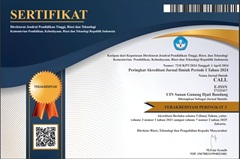HOW AN EFL TEXTBOOK TEACH LEARNERS' PRAGMATIC SKILL
DOI:
https://doi.org/10.15575/call.v6i2.37663Abstract
Abstract As a language learning resource, an English as a foreign language (EFL) or English as a second language (ESL) textbook plays a pivotal role in students' pragmatic development. There has been a plethora of studies conducted to evaluate the quality of textbooks across the countries regarding the proportional content of pragmatic uses. However, there is still no evidence of the study in Indonesia. Thus, to fill this void, the study aims to explore types of speech acts included in an EFL coursebook for senior high school students and to what extent those speech acts meet students' learning needs. This study employs a qualitative content analysis method, with one nationally mandated English textbook for senior high school students chosen and analysed. The analysis included categorizing dialogues in the textbook using Searle's (1976) Speech Act Theory, which comprises directive, commissive, representative/assertive, declarative, and expressive speech acts. The research findings indicate that the pragmatic content in the coursebook is still inadequate. This inadequacy may affect students' pragmatic development since proportional use of all types of speech acts would help learners use an appropriate speech act in an appropriate social setting. There is a call for more studies on the evaluation of EFL textbooks which use textbooks from all grades at senior high school level. Keyword: EFL textbook, pragmatics, speech act analysis
References
Astuti, R. W. (2018). The use of illocutionary acts in Jessie Nelson’s I am Sam. English Language & Literature Journal, 7(7), 694–702. https://journal.student.uny.ac.id/ojs/index.php/quill/article/view/14576
Hidayat, A. (2016). Speech Acts: Force Behind Words. English Education: Jurnal Tadris Bahasa Inggris, 9(1), 1–12.
Ishihara, N., & Cohen, A. D. (2014). Teaching and Learning Pragmatics: Where Language and Culture Meet. Teaching and Learning Pragmatics: Where Language and Culture Meet, July 2014, 1–370.
Kasper, G., & Schmidt, R. (1996). Developmental issues in interlanguage pragmatics. Studies in Second Language Acquisition, 18(2), 149–169. https://doi.org/10.1017/S0272263100014868
Kuo, F. Y., & Yin, C. P. (2011). A linguistic analysis of group support systems interactions for uncovering social realities of organizations. ACM Transactions on Management Information Systems, 2(1).
Laongpol, J. (2020). Speech Acts in Patriotic Songs Composed by Thailand’s Prime Minister Prayut Chan-ocha. New English Teacher, 14(2), 1–23.
Nguyen, T. M. T. (2011). Learning to communicate in a globalized world: To what extent do school textbooks facilitate the development of intercultural pragmatic competence? RELC Journal, 42(1), 17–30.
Norrick, N.R. (2016). Narratives in Conversation as Pragmemes. In: Allan, K., Capone, A., Kecskes, I. (eds) Pragmemes and Theories of Language Use. Perspectives in Pragmatics, Philosophy & Psychology, vol 9. Springer, Cham. https://doi.org/10.1007/978-3-319-43491-9_9
Searle, J. R. (1976). A classification of illocutionary acts. In: Language in society 5. Lang. Soc, 5(1), 1–24.
Soleimani, Dabbaghi, & Azizollah. (2012). -NonCommercial-NoDerivs CC BY-NC-ND Textbook evaluation: A reflection on the New Interchange Series Textbook evaluation: A reflection on the New Interchange Series. International Journal of Research Studies in Language Learning, 1(2), 19–32.
Soozandehfar, S. M. A., & Sahragard, R. (2011). A textbook evaluation of speech acts and language functions in top-notch series. Theory and Practice in Language Studies, 1(12), 1831–1838.
Sulviana. (2016). Analyzing Speech Act of Lecturer and Students in Class Discussion at English Department of Universitas Muhammadiyah Makassar. TEFL Oveseas Journal, 1, 15–28.
Vellenga, H. (2004). Learning pragmatics from ESL & EFL textbooks: How likely? Tesl-Ej, 8(2).
Widodo, P., & Sari, R. (2023). Pragmatic Role of Speech Act Communication PRAGMATIC ROLE OF SPEECH ACT COMMUNICATION AMONG NON-ENGLISH DEPARTMENT STUDENTS. Indonesian Journal of Education and Learning, 6(2), 14–25.
Zhou, G., & Niu, X. (2017). Conversational Dominance and the Asymmetric Distribution of Roles in Cross-Sex Conversations. International Journal on Studies in English Language and Literature, 5(9), 1–10.
Yule, G. (1996). Pragmatics. Oxford: Oxford University Press.
Downloads
Published
Issue
Section
Citation Check
License
Copyright (c) 2024 CALL

This work is licensed under a Creative Commons Attribution-ShareAlike 4.0 International License.
Authors who publish in CALL agree to the following terms:
- Authors retain copyright and grant the journal right of first publication with the work simultaneously licensed under Attribution-ShareAlike 4.0 International (CC BY-SA 4.0) License that allows others to share the work with an acknowledgment of the work's authorship and initial publication in this journal.
- Authors are able to enter into separate, additional contractual arrangements for the non-exclusive distribution of the journal's published version of the work (e.g., post it to an institutional repository or publish it in a book), with an acknowledgment of its initial publication in this journal.
- Authors are permitted and encouraged to post their work online (e.g., in institutional repositories or on their website) prior to and during the submission process, as it can lead to productive exchanges, as well as earlier and greater citation of published work (See The Effect of Open Access).




